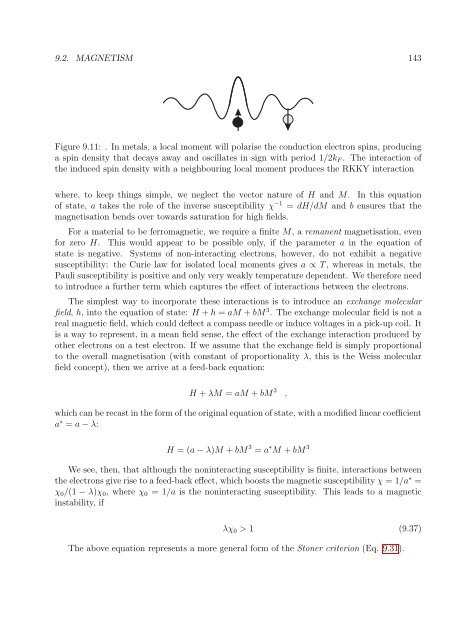Set of supplementary notes.
Set of supplementary notes.
Set of supplementary notes.
Create successful ePaper yourself
Turn your PDF publications into a flip-book with our unique Google optimized e-Paper software.
9.2. MAGNETISM 143<br />
Figure 9.11: . In metals, a local moment will polarise the conduction electron spins, producing<br />
a spin density that decays away and oscillates in sign with period 1/2k F . The interaction <strong>of</strong><br />
the induced spin density with a neighbouring local moment produces the RKKY interaction<br />
where, to keep things simple, we neglect the vector nature <strong>of</strong> H and M. In this equation<br />
<strong>of</strong> state, a takes the role <strong>of</strong> the inverse susceptibility χ −1 = dH/dM and b ensures that the<br />
magnetisation bends over towards saturation for high fields.<br />
For a material to be ferromagnetic, we require a finite M, a remanent magnetisation, even<br />
for zero H. This would appear to be possible only, if the parameter a in the equation <strong>of</strong><br />
state is negative. Systems <strong>of</strong> non-interacting electrons, however, do not exhibit a negative<br />
susceptibility: the Curie law for isolated local moments gives a ∝ T , whereas in metals, the<br />
Pauli susceptibility is positive and only very weakly temperature dependent. We therefore need<br />
to introduce a further term which captures the effect <strong>of</strong> interactions between the electrons.<br />
The simplest way to incorporate these interactions is to introduce an exchange molecular<br />
field, h, into the equation <strong>of</strong> state: H + h = aM + bM 3 . The exchange molecular field is not a<br />
real magnetic field, which could deflect a compass needle or induce voltages in a pick-up coil. It<br />
is a way to represent, in a mean field sense, the effect <strong>of</strong> the exchange interaction produced by<br />
other electrons on a test electron. If we assume that the exchange field is simply proportional<br />
to the overall magnetisation (with constant <strong>of</strong> proportionality λ, this is the Weiss molecular<br />
field concept), then we arrive at a feed-back equation:<br />
H + λM = aM + bM 3 ,<br />
which can be recast in the form <strong>of</strong> the original equation <strong>of</strong> state, with a modified linear coefficient<br />
a ∗ = a − λ:<br />
H = (a − λ)M + bM 3 = a ∗ M + bM 3<br />
We see, then, that although the noninteracting susceptibility is finite, interactions between<br />
the electrons give rise to a feed-back effect, which boosts the magnetic susceptibility χ = 1/a ∗ =<br />
χ 0 /(1 − λ)χ 0 , where χ 0 = 1/a is the noninteracting susceptibility. This leads to a magnetic<br />
instability, if<br />
λχ 0 > 1 (9.37)<br />
The above equation represents a more general form <strong>of</strong> the Stoner criterion (Eq. 9.31).








